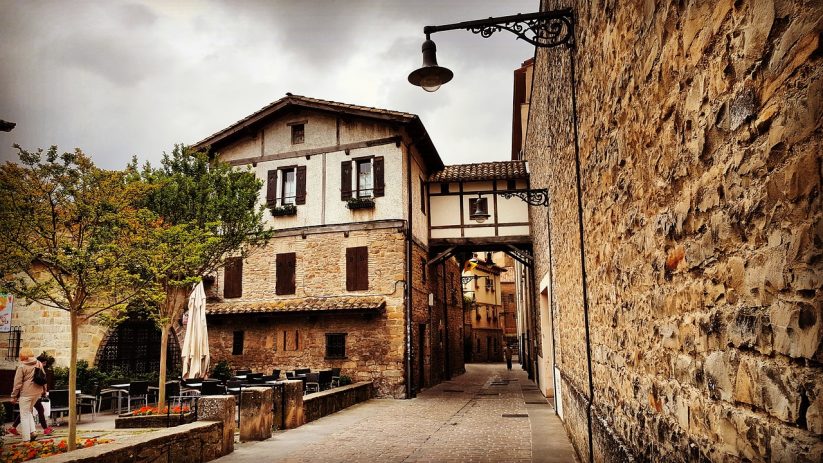Santa Clara University Article
Walking the Camino to Santiago in Spain, and learning a few things along the way: about big questions, saints, direction, and feet.
Which route would we take? Jim Reites, S.J. MST ’71, an associate professor of religious studies at Santa Clara who did almost 200 miles of the Camino with some SCU students in 2006, recommended the French route, the Camino Francés, for first-time pilgrims; it’s more populated and better supported. Another colleague took three weeks to hike part of the same route, and he’d done only parts of it. He recommended a flexible schedule, a few advance bookings, and some online research. “You walk your own Camino,” he told me. I didn’t realize the layers of truth in his words.
You do walk your own Camino; you can’t walk someone else’s. Nor can you let anyone else set your pace, carry your pack, or deal with your demons.
At the time, though, I thought my friend referred to the route. After consulting calendars and train tables, I plotted out ours. We’d start in Pamplona, where Ignatius Loyola was injured defending the city against the French in 1521. The city fell, artillery shattered his right leg, and Ignatius began a long interior transformation from courtier to “pilgrim.” From Pamplona we’d hike to Burgos, walking some 130 miles in 11 days. Then we’d take a train across the hot, dry plateau of central Spain to Ponferrada. In another 130 miles we’d reach Santiago.
In the beginning: Pamplona
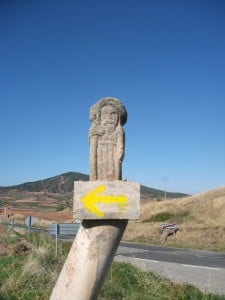
When I started looking, I noticed arrows everywhere: on a pole, a tree, a stone, a marker set into the path. On the Camino, I spotted yellow arrows on the sides of houses, on telephone poles, on road signs pointing somewhere else, even in the middle of the road.
I learned to trust in the yellow arrows. Just when I needed one, it would be there. Not only did arrows point the way, they signaled that someone else had been there before me—and not just anyone, but someone with my own special set of anxieties. It gave me great heart.
The arrows I loved best were the ones in the middle of a long straightaway. There had been no turnoffs and no forks in the road. The yellow arrow just there, a sign of mute encouragement.
Encouragement: Marking the way for each other
Taking the hint, we become yellow arrows to one another. The way was long, the sun was hot, the feet were sore. We always greeted passing pilgrims with “Hola!” or “Buen camino!” That was worth 400 milligrams of ibuprofen, which we downed like M&Ms. Along the way, we fell into conversations that eased the pain and made the industrial outskirts of a big city seem less ugly.
After all, we shared common ground—quite literally. “Where did you stay last night?” “How far are you going today?” “How are your feet?” Questions like these displace the usual others: “Where are you from?” “What do you do?”
We hiked into Burgos with a couple from Holland. She was a financial planner taking an unpaid sabbatical from her firm to hike the Camino. In the throes of recession, her company was happy to have her off the payroll for five months. She confessed that it had been a tough year; her clients felt anxious and under siege. “People don’t have money,” she said, “rather, their money has them.” Now on Camino, she practiced working to live, not living to work.
We left her with her husband in front of the municipal hostel in Burgos. Though she could have stayed at the finest hotel in the city, she sounded like someone who knew exactly what money could buy—and what it couldn’t.
Lisa and I weathered the end of several long days by making up stories. We spun out a long, shaggy-dog story about an American we met working in a hostel in some small, almost-Alpine village on the edge of Galicia. We gave him a background, some dreams, some companions, and some history. One of us picked up the story from where we ended it the day before, turned it in some wonderfully quirky way, then passed it off to the other.
The genre of our tale fell somewhere between Gothic romance and Jesuit science fiction: Think Mary Doria Russell meets Barbara Cartland. We walked through a lot of pain telling stories.
Why do they walk?
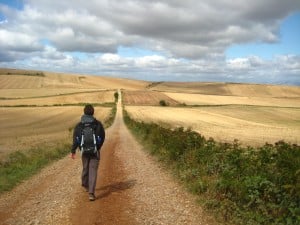
Giovanni, an Italian journalist, told me about forms in Roncesvalles at the beginning of the Camino Frances that posed our question in writing. The forms listed four possible reasons for the pilgrimage: spiritual, cultural, social, and sport. He simply checked them all. When I asked how much time he was taking for the trek, he said he had an open return. He didn’t even know whether he would have a job when he got back.
“I need to lose some things,” an Australian woman replied. She was not alone. Pilgrims practice losing things. They pick up stones in the morning, setting them down later in the day. The ritual creates pockets of cairns along the trail. One afternoon, I stumbled upon a whole valley of them; the place felt already populated. The stones symbolize other “stuff ” pilgrims leave behind: a broken relationship, the loss of a loved one, a particular phase of life.
“What brought you here?” An American couple recently retired to Santa Fe, N.M., said simply: “We’re in Stage Three. And we need to think about what that means for us.” They’d raised children, had careers, and weren’t ready for endless days of golf and bridge. “I don’t know what comes next, but it will involve service. Life without service is not worth living,” Chris said. The Camino would help them discern their new vocation.
“What brought you here?” My favorite answer came from Eric, a Danish therapist. I’d walked with him one afternoon, then spotted him in a busy street a few days later. He yelled across a street streaming with children, townsfolk, and tired pilgrims: “I’m a child again!”
How would I answer the question I kept posing? Probably like Giovanni, I would check all available options, add a few of my own, and leave a few empty lines for the answers I can now only dimly discern.
I remember a year ago, when Lisa and I climbed Mt. Kilimanjaro: “Why do you have to do this?” people asked. Invoking the spirits of George Mallory and Mt. Everest, Lisa said solemnly: “Because it’s there!” I shrugged and said: “Someone invited me.” That usually closed down further questioning.
In retrospect, those answers work for the Camino. They signal two habits of the pilgrim heart. On one hand, there is a spirit of surrender: “Because it’s there!” Though terrain differs, both the Camino and Kilimanjaro feature “fierce landscapes.” Teresa of Avila called Spain a land of “stones and saints,” and on Kilimanjaro all those stones are at high altitude. Some climbers boast of “conquering” the summit, just as some pilgrims brag about “making it” all the way to Santiago. They wear their destinations as accomplishments. I felt differently: The path let me go forward, and I leaned into it with awe and gratitude.
On the other hand, my response expresses a spirit of invitation: “Someone invited me.” Kilimanjaro wasn’t on my bucket list, but when a friend asked me to come along, I could only say yes. I didn’t need to “conquer” the summit. Instead, I channeled Abraham. Invited by God to go on a journey, destination unknown, he simply said yes. He trusted the One calling him.
Why do they walk? Surrender and invitation weren’t options on the forms issued at Roncesvalles. But they remain pretty good answers.
Marking the way: a storied route
At some point along the trail, though, all the lyrical little villages began to look alike. To distinguish them, I had to remember their stories. One in particular had a nondescript, shaded square where a father played with his three children, pushing them on a swingset. When they ran off to chase a cat, he sat on the swing, rocking back and forth. Then he stopped, went over to his car, fiddled with the dashboard—and suddenly the plaza filled with opera. He grinned, took his seat again, and began swinging in time to the music. I stood on the picnic table and sang along, punctuating the high notes with hiking poles.
This village we remembered.
So it is with the Camino itself. We remember its parts by its people. Eric the Therapist and Sophie the Jazz Dancer went on ahead of us, leaving us with Richard and Caroline, a couple from England. Without fail we found them in the church at the end of the day, and the four of us held an impromptu seminar on local religious iconography. For several days, we bumped into Nancy and Linda, an American and Aussie who’d met in Roncesvalles and decided to walk together. One night, they popped into a crowded bar in Belorado, the only place open during a five-day fiesta: “I’m so glad to see you,” I shouted over the din. “It always makes me feel like I’m on the right track.”
Just as we distinguished the villages by the stories we found there, so we remembered the Camino by its pilgrims. A path marked with yellow arrows became marked with people instead.
Saints and more saints
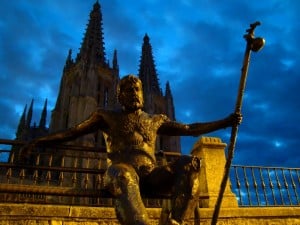
Perhaps that’s why I was so moved by the presence of the Virgin Mary along the Camino. She has many incarnations. Our journey had started in Pamplona at a plaza dedicated to the Virgen de la O. We entertained ourselves for hours imagining what the “O” might stand for. At a Franciscan church in Santiago, we discovered Nuestra Señora de Valvanera, Our Lady of the Valley of Venus. Many churches featured images of the Madonna de la Leche, Mary nursing an infant Jesus who reaches hungrily for her breast.
Mary sticks with Jesus until the end. As the Mater Dolorosa, she wears black, weeps glass tears, and bleeds from seven swords piercing her heart. We often found this image over an altar with the crucified Jesus entombed underneath. This Spanish Pietà radiated anguish: A mother reaches out for a dead child, who is further separated from her by a marble slab.
Most often, though, we saw Mary with the infant Jesus on her lap. Invariably, one of them held an apple, for incarnation inaugurates a new creation. Jesus and Mary become the New Adam and New Eve. Together they clean up the chaos of the first creation: Nuestra Señora of Second Chances.
As she participates in the ordinary joys and sorrows of human life, Mary becomes a very plastic image. The route may be named after St. James, but Mary really is the Lady of the Camino. She’s everywhere, because she’s on our side.
James plays a more ambiguous role in the Camino’s religious iconography. Sometimes he appears as the Pilgrim Saint, having been deputized by Christ to go to Galicia and convert the Druids. According to legend, he had modest luck and returned to Jerusalem, where he was promptly beheaded around 44 C.E. His disciples returned with his body to Galicia.
There James gets reincarnated as the Knight: Santiago Matamoros, James the Slayer of Muslims. Historically, this never could have happened: James lost his head centuries before Muhammad was even born. But the Moors inhabited much of Spain in the Middle Ages, and history took a backseat to need. Once Christian armies found victory marching into battle bearing James’ bones, religious art turned triumphalist. James appears on horseback and killing Muslims.
In the 16th century, the conquistadores brought James the Knight with them to the Americas. There he took on another job description: slayer of the Aztecs, the Incas, the Mayans, and anyone else who interfered with the juggernaut of empire. This time James is on horseback and killing native peoples.
Those who weren’t killed were Catholicized. Yet, the saints of New Spain only thinly covered the already existing gods and goddesses of the Aztec, Mayan, and Incan religions. Native peoples adopted Catholic saints—and then adapted them. In the Guadalupe, Mary takes on the traits of Tonantzin, Aztec goddess of the heavens. James the Knight takes on traits of Illapa, the Incan god of lightning, thunder, and rainstorms.
With the nationalist movements in the Americas of the 18th and 19th centuries, images emerge of Santiago Mataespañoles, James the Slayer of the Spaniards. The conquering saint takes the side of the conquered peoples. In Pamplona we witnessed the transformation of Ignatius of Loyola from Knight into Pilgrim. On the Camino we watched the apostle James morph from Pilgrim to Knight.
Mary and James: Their images are labile, telling more about the people who revered them than the saints themselves. Then again, saints always do. They embody the deepest needs of the human heart, both its darkness and its beauty.
I’m struck with these two saints and their images, one of carnage and conquest, the other of nurture and compassion. Despite the peace that Jesus preached, lived, and embodied, we still turn to James to fight for us—and to Mary to feed us and to share our tears.
Footnotes: “Oh, beautiful, for pilgrim feet…”?!
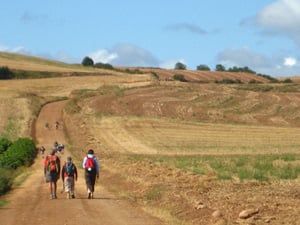
On the Camino, pain becomes a constant companion. Fortunately, every village, no matter how small, has a pharmacy, and infinitely patient people staff them. All day long they listen to broken Spanish spoken with German, American, British, Aussie, Norwegian, or Korean accents. One pilgrim didn’t speak at all; he simply lifted his foot onto the counter. Without expression, the pharmacist regarded it, then disappeared into the recesses of his store and returned with bandages, ointment, and tape. He gestured what needed to happen, but his lack of revulsion was probably the best medicine.
We packed sewing kits for our clothes; we used them on our feet. Sterilized needles puncture swollen blisters; thread keeps them drained. Surgery with a sewing kit courts infection, which could close down a pilgrimage. If we could avoid infection, though, we could walk through our blisters. Silently offering a prayer to Nuestra Señora of Second Chances, we sewed our feet.
On the Camino, dressing our feet was a necessary morning ritual. Once in Santiago, though, we stopped. After a few days there, I ran into some friends from an earlier part of the route: “You look great!” someone said. She was right: I’d spent the morning making up my face, not my feet.
Pilgrims don’t look great; they look tired, weary, and stressed. Katharine Lee Bates gets the quality of force:
Whose stern impassioned stress
A thoroughfare of freedom beat
Across the wilderness!
But how purposeful she makes us sound! In reality, pilgrims dawdle. I can’t tell you how many times during the course of a day I packed and unpacked my frame, laced and unlaced my boots, and shed socks and boots entirely to let the wind blow through my blisters.
The reality of pilgrimage is pretty gritty. We’re not Bates’ beautiful and beautifully determined band of soldiers. We didn’t march—we writhed into Santiago, like some spineless, gelatinous mass. When we got there, we stank, we ached, we wanted nothing more spiritual than a shower. The Botafumeiro is a big pot of incense that’s swung at the daily pilgrim Mass in the Santiago Cathedral. It’s not there for decoration; it cuts the smell, along with fumigating us all.
In describing the Christian church, St. Augustine (354–430 C.E.) turned to the image of pilgrimage. The church was a pilgrim church; life on Earth, a pilgrimage, land believers, pilgrims or peregrini. Before the Camino, whenever I read this, I used to hear “America the Beautiful” in the background. Now I see that smelly crowd that slithered into Santiago. It’s not pretty, but it’s a lot closer to the truth.
Re-entry I: The stuff
What’s it like to be back? Again and again, I find I have too much stuff. After carrying everything on my back for four weeks, I come home to a house full of things I needed four weeks ago that now seem superfluous.
On the Camino, I tore chapters out of a book as I read them and tossed them in trash bins. I brought along the daily lectionary every morning, then put the day’s readings in my back pocket until I found the right place to leave them. Once it was on a café table in Villafranca—and the waiter crossed the plaza to return them. Now, back in ordinary time and ordinary life, it’s hard to shake this feeling of having too much baggage. What do I really need?
This winnowing process works on several levels. Possessions are the easiest to identify—and jettison. Relationships also carry a lot of baggage, and I bring a lot of baggage into them. How can I unburden them? How can I be a lighter spirit and a more gracious presence?
The Camino confirmed that I’m a world-class worrier. I always have Plan B in place, should Plan A fail. Moreover, I not only have the plan, but all the gear for Plan B. I even have gear for Plans C and D. What usually happens, of course, is Plan Q, which turns out to be better than anything I could have scripted—and for which all the right “stuff ” miraculously appears.
How can I unburden myself in that way? I’m carrying about 25 pounds of possible outcomes and all the attendant frets that go along with them.
Re-entry II: The spirituality
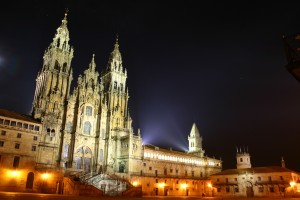
I thought it would be more spiritual, too. Originally, we’d planned to walk the questions posed in John’s gospel, pondering one question each day. There are some great ones, worthy of weighty consideration: “What are you looking for?”
“Do you want to be made well?” “Do you also want to go away?” And Pilate’s hauntingly cynical: “What is truth?”
On the Camino, however, the questions that consumed us were quite different: “Was that the alarm?” “Should I be paying attention to this pain?” “Can we stop for a café con leche?” “Are we there yet?”
So much for John’s questions.
But I could tell you the phases of the moon along the trek, when the first light comes, how the sun glints off the lantern of the cathedral of Santiago. I could describe magical forests in Galicia and how the morning mists create islands of the hills surrounding O’Cebreiro. I now know how to get laundry done, where to find the laundromats, and what “auto-servicio” really means: Bring us your dirty clothes and pick them up two hours later. I could tell you about the Madonnas and Santiagos who walked with us.
This is not the spirituality we anticipated; it’s the spirituality we got. Is this real spirituality?
Here’s what I know. First, the spirituality we encountered was deeply embodied. As scholars we tend to live in our heads. On pilgrimage we couldn’t do that. We had to live in our feet instead. If they didn’t work, there was no going forward. When I apologized to another friend for the “unscholarly” character of my blog postings, she smiled: “Actually, you had quite a lot of footnotes.” She was right: We wrote a lot about our feet.
Pilgrimage made me appreciate how we are “fearfully and wonderfully made” (Psalm 139:14). Bodies have an organic integrity, and I came to a new understanding of the powerful image of the “body of Christ.” The apostle Paul spells it out for the smugly cosmopolitan Corinthians: “There are many members, yet one body. The eye cannot say to the hand, ‘I have no need of you,’ nor again the head to the feet, ‘I have no need of you.’” An “inferior” member of the body became all-important: We had need of our feet.
Second, we came to honor the Sabbath, whenever it fell. Lisa joked about the need for “horizontality.” Aching for a brief respite from walking, we’d fall into bed or onto a patch of grass and rise refreshed. We made a pact to break for no less than 30 minutes, unless it was pouring rain or cows were heading straight at us. When we needed a “day off,” we took it—without apology. Rest repaired us.
Finally, we surrendered our independence—at least a little. I counted on my colleague’s unfailing good humor. Nothing blunted Lisa’s wit—not fatigue, not rain, not blisters. I depended on the people we’d meet along the way: We cheered each other on. Encouragement pushed our pilgrim feet forward.
It was not the spirituality we expected, perhaps, but it was the spirituality we were given. We scooped it up and let it pour over us.
